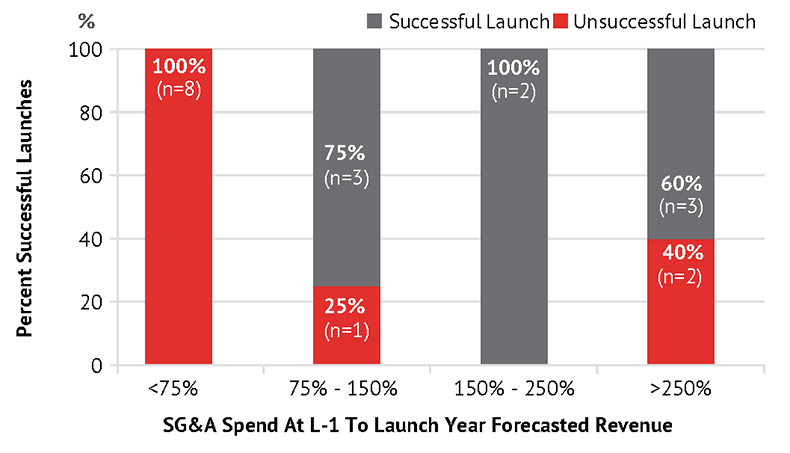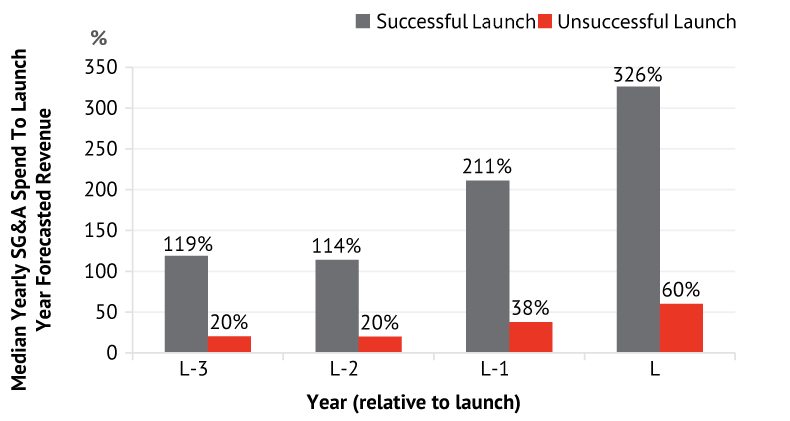Executive Summary
In the increasingly complex world of biopharmaceutical commercialization, executives at emerging companies are often faced with the need to understand what levels of spend are appropriate for successfully launching a product. Many clinical-stage companies find themselves either underfunding launches and underperforming in the market, or overfunding launches and incurring costs that do not add incremental value to commercial success. And while every company is different, and every launch is different, all face the same question: What is the threshold of commercial spend needed to increase the probability of a successful product launch?
We attempted to answer this question through an in-depth analysis of pre-launch and launch SG&A spend in a sample of emerging companies launching their first product.
This article presents our key findings and discusses factors that, in our experience, influence variability in SG&A spend in the years leading up to launch.
Our Methodology
We compared three financial metrics SG&A spend, forecasted revenues and actual revenues - across target companies to determine the relationship between pre-launch/launch spend and launch success. Financial information was retrieved from public sources, including company reported 10Ks, annual reports and analyst research reports. For standardization purposes, SG&A spend is presented as both absolute dollars and as a percentage of launch year forecasted revenue. All figures are reported in US dollars ($). In terms of geographic relevance, this analysis is more applicable to US launches.
Nineteen companies were identified for this analysis. Inclusion criteria for emerging companies were:
- Biopharmaceutical company launching its first product
- First launch occurring between 2005 and 2015, inclusive
- Company financials publicly available
- Therapeutic product
Exclusion criteria were:
- Large pharmaceutical company launch
- Company experiencing a merger or acquisition prior to launch or during the launch year
- Medical devices and diagnostic products
Key Insights
How Much Do Emerging Companies Spend Before and During the Launch Year?
On average, our sample of emerging companies spent a total of $187 million in SG&A across the three years preceding launch and during the launch year. While this spend varied significantly depending on the indication, customer base, product type or corporate strategy, our analysis suggests that a new product requires at least $130 million of SG&A spend, in the four-year timeframe assessed in this study, to support its launch (see Exhibit 1).
When analyzing SG&A spend by year, we found that companies spent on average $21 million three years before launch year (L-3), $28 million in L-2, $44 million in L-1 and $94 million in the launch year (Exhibit 1). Companies exponentially increased SG&A spend as they approached launch, nearly doubling spend from L-1 to launch year. Additionally, the variability of annual SG&A spend, as illustrated by lower and upper spend ranges, increased every year through launch.
How Does Pre-Launch Spend Correlate with Launch Success?
Only 42% of the companies analyzed had successful launches where they met their target forecast. We found that successful launches were associated with significantly higher pre-launch and launch SG&A spend than unsuccessful launches.
While all companies in our study increased SG&A spend each year up through launch, companies that spent a minimum of 75% of their launch year forecasted revenue during L-1 had higher rates of launch success (Exhibit 2). Even more importantly, not a single company that spent less than 75% of their launch year forecasted revenue in L-1 achieved a successful launch.
Conversely, there is an upper limit beyond which higher SG&A spend does not necessarily yield additional commercial benefit. Excessive spend in L-1 (i.e., above 250% of the launch year forecasted revenue) did not correlate with higher rates of launch success. In fact, 40% of companies in this range did not achieve a successful launch. Disproportionately high spending in L-1 could depend on several factors, including last-minute spending in an attempt to salvage a launch or delaying spend to align with regulatory or financial milestones.
As a final analysis, we compared SG&A spend of companies that had a successful launch to those companies that did not. Specifically, the median SG&A spend of successful companies was ~120% of their launch year forecasted revenue in L-3 and L-2, ~210% in L-1, and ~330% in the launch year. In contrast, the median SG&A spend for unsuccessful companies was less than 40% of their launch year forecasted revenue in each of the years preceding launch and only 60% in the launch year (Exhibit 3).
What Factors Typically Influence SG&A Spend?
There are a variety of factors – both internal to the company and external from the market – that affect a company's pre-launch spend decision.
Key internal factors are a company’s financial situation, level of development risk and corporate strategy. Examples for each factor are illustrated below.
Financial Situation: Companies with a limited budget are more likely to stage-gate spend according to expected development and financial milestones, such as clinical program progression, regulatory filing acceptance/approval, fundraising, and partnering agreements.
Level of Development Risk: When facing lower probability of technical or regulatory success, such as developing unproven classes of drugs/MOAs or launching in therapeutic areas with limited regulatory precedents, companies are more likely to closely monitor or stage-gate spend.
Corporate Strategy: Emerging companies looking to be acquired or to divest their asset may limit SG&A spend in order to preserve their funds-at-hand for development and regulatory activities critical to achieving product approval.
On the other hand, the largest external factors affecting level of spend typically relate to customer base characteristics and the competitive landscape for the product indication.
Disease Characteristics: Depending on the disease characteristics, a product may require a direct-to-consumer (DTC) campaign or a robust disease awareness program, which typically translates into significant SG&A spend.
Competitive Landscape: Companies launching in a highly competitive market will generally spend more in SG&A to differentiate against competitors and demonstrate product value.
While no two companies are the same or face the same circumstances, our analysis provides general guidance on the range of pre-launch and launch SG&A spend that has historically led to successful launches. Emerging companies should be cognizant of their level of spend in light of our findings that spending less than 75% of launch year forecasted revenue resulted in unsuccessful launches across the board. A strategic analysis of influential factors, such as level of development risk, corporate strategy, customer base characteristics and competitive landscape can help emerging companies determine whether to spend more or less, earlier or later in the process as they bring their first product to market.
For more of our thinking on this topic, please Click Here.


